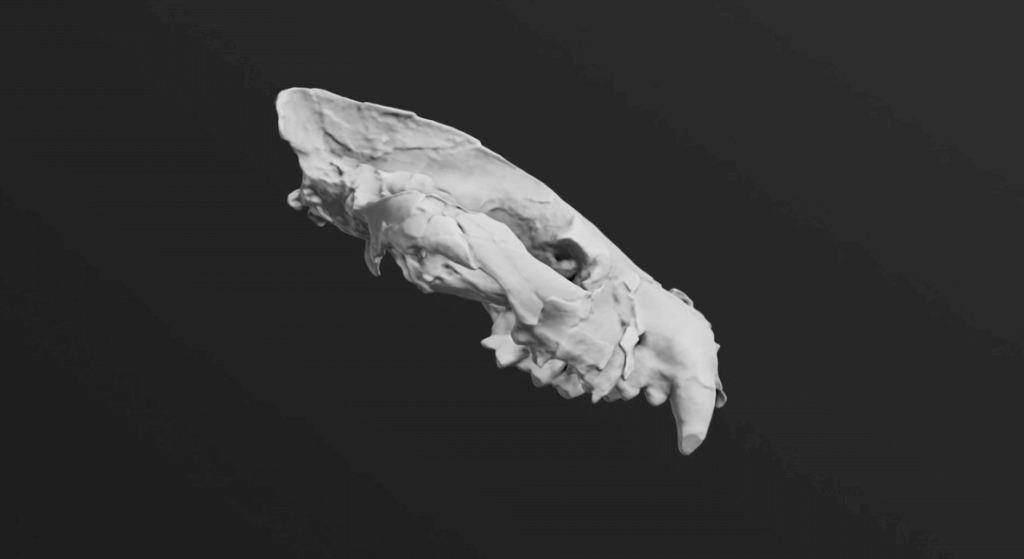

Bastetodon syrtos reconstruction (Credit: Professor Hesham Sallam)
In a nutshell
- Scientists have discovered a remarkably complete skull of a new prehistoric carnivore species in Egypt’s Fayum Depression, named Bastetodon syrtos, which lived about 30 million years ago and was roughly the size of a modern leopard
- The discovery has led researchers to correct a century-old misclassification of ancient African predators, showing they evolved separately from their European relatives rather than being part of the same group
- The fossil comes from a crucial time period when Earth’s climate was changing from warm to cool, helping scientists understand how climate change affected prehistoric predator evolution and eventually led to their extinction when modern carnivores arrived in Africa
MANSOURA, Egypt — In the desert sands of Egypt’s Fayum Depression, an extraordinary discovery began with an excited shout. A team member had spotted large teeth protruding from the ground, leading to what lead author Shorouq Al-Ashqar calls “a dream for any vertebrate paleontologist.” Researchers uncovered the nearly complete skull of an ancient apex predator that prowled North Africa roughly 30 million years ago.
Named Bastetodon syrtos after the ancient Egyptian cat-headed goddess Bastet, this fearsome carnivore was similar in size to a modern leopard and represents one of the best-preserved fossil skulls ever discovered from this period in Africa. The findings, published in the Journal of Vertebrate Paleontology, reveal how the name cleverly combines Bastet with “odon” (meaning tooth), referencing both the region’s rich archaeological heritage and the creature’s distinctive dental features.
Weighing around 27 kilograms (60 pounds), Bastetodon belonged to an extinct group of carnivorous mammals called hyaenodonts. These predators evolved in the aftermath of the dinosaur extinction and dominated African ecosystems for millions of years. Unlike modern meat-eaters who typically have one pair of specialized cutting teeth, hyaenodonts had multiple pairs of these slicing teeth in their jaws, making them particularly effective predators.


During their reign, Bastetodon and its relatives would have preyed upon early primates, primitive hippos and elephants, and hyraxes in what was then a lush forest environment. This was a crucial period in evolutionary history, as many of the mammal groups we know today were just beginning to emerge and diversify.
The discovery came during a meticulous excavation by the Sallam Lab team, as they worked through rock layers dating back 30 million years. The exceptional preservation of the skull gives scientists unprecedented insights into how these ancient predators lived and hunted, during a time when our own monkey-like ancestors were evolving.
The Fayum area where Bastetodon was found tells a remarkable story of environmental change. Today, it’s an arid desert, but 30 million years ago, it was a very different place. The region preserves approximately 15 million years of evolutionary history, capturing a dramatic global climate transition. During this period, Earth shifted from the warm conditions of the Eocene epoch to the cooler climate of the Oligocene, changes that would reshape ecosystems worldwide.


Scientists can read these changes in the rock layers. The fossils found alongside Bastetodon reveal a landscape dotted with waterways and forests that supported a diverse community of animals. This environment was quite different from both earlier and later periods, providing a unique window into a lost world.
The skull itself is a treasure trove of information about how Bastetodon lived. Several features reveal its predatory lifestyle. It had robust attachment points for powerful jaw muscles, similar to those seen in modern big cats. Its specialized blade-like teeth were perfect for slicing through meat, while its shortened, cat-like snout created a strong bite. Through evolution, it had lost certain teeth, specifically its first premolar and third molar, a modification that actually made its bite more efficient.
But Bastetodon‘s significance extends beyond just adding another species to the prehistoric record. The discovery has led to a major reevaluation of African carnivore evolution. While examining this new specimen, researchers realized that some similar fossils found in the same region over 120 years ago had been misclassified.


These older specimens, which came from lion-sized predators, had been grouped with European species. Now, researchers have created a new genus for them called Sekhmetops, named after the lion-headed goddess of war, Sekhmet. This reclassification corrects a century-old misunderstanding and demonstrates that Africa was developing its own unique lineages of predators.
These predators originated in Africa and spread in multiple waves across continents, reaching Asia, Europe, India, and North America. By 18 million years ago, some relatives of these hyaenodonts had evolved into some of the largest mammalian carnivores ever known.
“The Fayum is one of the most important fossil areas in Africa. Without it, we would know very little about the origins of African ecosystems and the evolution of African mammals like elephants, primates, and hyaenodonts,” says study co-author Matt Borths, Curator of Fossils at the Duke Lemur Center Museum of Natural History, in a statement.


Major climate changes and tectonic shifts in Africa eventually allowed the ancestors of modern carnivores like early cats, dogs, and hyenas, to enter the continent. As environments and prey species changed, the specialized hyaenodonts couldn’t adapt quickly enough. Their diversity declined until they eventually went extinct, leaving our primate ancestors to face new predatory threats.
What makes the Fayum Depression particularly valuable to scientists is its continuous record of fossils across this crucial time period. Most fossil locations only preserve snapshots of prehistoric life, but the Fayum’s layers contain a more complete sequence of evolutionary change. Each new discovery, including Bastetodon, adds another piece to this complex puzzle.
This discovery provides crucial insights into the evolution and global distribution of these ancient predators. As research continues in the Fayum Depression, each new find helps reconstruct the story of how Africa’s prehistoric ecosystems evolved into those we know today.
Paper Summary
Methodology
Researchers used a combination of traditional and cutting-edge techniques to study the Bastetodon skull. The specimen was carefully excavated from Quarry I in Egypt’s Fayum Depression and prepared at Mansoura University. The team then created detailed 3D scans using both micro-CT technology and laser scanning, allowing them to examine internal structures and create precise digital models. They compared the fossil to other known specimens and used sophisticated computer analyses to determine its relationship to other ancient carnivores.
Results
The analysis revealed that Bastetodon weighed around 27 kg, similar to a modern spotted hyena. It had specialized features for meat-eating, including powerful jaw muscles, blade-like teeth, and a shortened snout. The study also showed that African specimens previously classified as Pterodon were actually distinct from European species, leading to new classifications. The research confirmed an African origin for this group of carnivores, with multiple later dispersals into Eurasia.
Limitations
As with many paleontological studies, the research was limited by the fossilized material available. While the skull is remarkably complete, no other skeletal elements were found, limiting what can be known about the animal’s overall body structure and locomotion. Additionally, the methods used to estimate body mass rely on comparisons with modern carnivores, which may not perfectly translate to these extinct species.
Discussion and Takeaways
The study significantly revises our understanding of ancient African carnivores and their relationship to European species. It demonstrates that Africa was an important center of evolution for these predators and shows how they dispersed across continents over time. The research also provides insights into how specialized meat-eating adaptations evolved in different mammal groups.
Funding and Disclosures
The research was supported by multiple institutions including Mansoura University, American University in Cairo, and various scientific funding bodies including USAID, the Egyptian Ministry of Higher Education, and the Science and Technology Development Fund. The researchers declared no conflicts of interest.
Publication Information
The study, titled “Cranial anatomy of the hypercarnivore Bastetodon syrtos gen. nov. (Hyaenodonta, Hyainailourinae) and a reevaluation of Pterodon in Africa,” was published in the Journal of Vertebrate Paleontology on February 16, 2025.








